Numerical Study on Failure Mechanisms of Deep Roadway Sidewalls with Different Height-Width Ratios and Lateral Pressures
Abstract
1. Introduction
2. Project Overview
2.1. Failure Characteristics of Roadway Sidewalls
2.2. In-Situ Stress
- (1)
- The azimuth angles of the principal stress σ1 of the two measuring points are 154.91° (borehole 1) and 156.79° (borehole 2), respectively, values which are basically consistent with the principal stress direction in North China. Near east-west (the Datai coal mine is east of Taihang Mountain), the azimuth angle of borehole 2 is 224°, and the included angle with the azimuth angle of σ1 is 67.21°. The core discing phenomenon appeared in borehole 2, as shown in Figure 4. This is a main feature of rock masses under high ground stress.
- (2)
- At the two measuring points, σ1 had dip angles of −2.11° and −2.40°, respectively. σ1 is oriented in a near-horizontal direction, suggesting that the in-situ stress in this area is mainly characterized by horizontal compressive stress. Therefore, it is necessary to study the effect of horizontal ground stress on the safety of the rock mass, which can be determined by changing the lateral pressure coefficient.
- (3)
- The principal stress values of the two measuring points in the near vertical direction are 24.44 MPa and 25.63 MPa, respectively, values which are basically equal to the pressure of the overlying strata per unit area at the −510 m level.
- (4)
- The differences between the dip angles of σ1 and σ3 at the two measuring points are 11.06° and 12.35°, respectively. The differences between the dip angles are small and similar to the horizontal direction. At the same time, σ1 is 2.39~2.67 times the minimum principal stress σ3, and the difference is larger. Shear failure in the rock mass of a sidewall is serious.
3. Materials and Methods
3.1. Model Size and Parameters
3.2. Simulation Scheme
4. Results and Analysis
4.1. Influence of Roadway Height-Width Ratio
4.1.1. Plastic Damage Zone of Roadway Sidewall
4.1.2. Horizontal Displacement of Roadway Sidewall
4.1.3. Vertical Stress of Roadway Sidewall
4.2. Influence of Lateral Pressure Coefficient
4.2.1. Plastic Damage Zone of Roadway Sidewall
4.2.2. Horizontal Displacement of the Roadway Sidewall
4.2.3. Vertical Stress of Roadway Sidewall
5. Conclusions
- (1)
- The rock surrounding the roadway of the Datai coal mine is under high in-situ stress, and the diabase is dense and brittle. The roadway sidewall damage mostly occurs in the upper middle or middle-lower part, mainly as shear failures, forming a large falling block fissure with a wide range, and finally forming a V-shaped failure zone.
- (2)
- When the height-width ratio of the roadway increases from 0.25 to 2.00, the tensile and shear plastic zones of the roadway sidewall gradually expand. The tensile plasticity damage zone is V-shaped, and the shear plasticity damage zone is circular. In addition, the shear plastic damage zone is larger than the tensile plastic damage zone. The vertical stress in the roadway sidewall experiences two peaks. The stress decreased slightly between the peaks, and then gradually decreased and stabilized. It was found that the horizontal displacement of the roadway sidewall increased linearly. With the rise of the roadway height-width ratio h/w, the values of the two peaks get closer and closer. The stress at the two stress concentration points increases and then decreases, and the stress concentration location is gradually shifted to a deeper part of the roadway sidewall.
- (3)
- As the λ value increases from 0.1 to 1.0, the tensile plastic damage area of the roadway sidewall first decreases and then remains unchanged, and the shear plastic damage zone first increases and then decreases. The horizontal displacement of the roadway sidewall shows a trend of decreasing and then increasing. The vertical stress within the roadway sidewall increases at the first peak point, then decreases slightly, and then continues to increase to the second peak point. The stress value decreases linearly at the first stress concentration point and tends to increase and then decrease at the second stress concentration point. Then it gradually decreases and stabilizes. The stress value decreases linearly at the first stress concentration point and tends to increase and then decrease at the second stress concentration point. It is worth noting that these two stress concentration locations are shifted to the boundary of the roadway sidewall.
Author Contributions
Funding
Institutional Review Board Statement
Informed Consent Statement
Data Availability Statement
Conflicts of Interest
References
- Yi, X.; Gao, F.; Liu, X. Permeability and pressure distribution characteristics of the roadway surrounding rock in the damaged zone of an excavation. Int. J. Min. Sci. Technol. 2017, 27, 211–219. [Google Scholar]
- Gong, W.; Peng, Y.; He, M.; Xie, T.; Zhao, S. An overview of the thermography-based experimental studies on roadway excavation in stratified rock masses at CUMTB. Int. J. Min. Sci. Technol. 2015, 25, 333–345. [Google Scholar] [CrossRef]
- Sun, X.; Wang, D.; Feng, J.; Zhang, C.; Chen, Y. Deformation control of asymmetric floor heave in a deep rock roadway: A case study. Int. J. Min. Sci. Technol. 2014, 24, 799–804. [Google Scholar] [CrossRef]
- Wang, H.; He, S. Stability analysis of surrounding rock of shallow-buried subway tunnel with small spacing under different working conditions. Geotech. Geol. Eng. 2022, 40, 5065–5079. [Google Scholar] [CrossRef]
- Gao, B.; Yang, C.; Li, L.; Zhang, H.; He, W.; Yang, Z.; Cai, Z. Surrounding rock failure mechanism and long-term stability of the heidong large ancient underground caverns. Geotech. Geol. Eng. 2022, 40, 4975–4990. [Google Scholar] [CrossRef]
- Mangal, A. Strata Stability Investigation and Convergence Monitoring (SSICM) in Thick-Seam Depillaring with Caving by Cable Bolting Method. Min. Metall. Explor. 2021, 38, 927–944. [Google Scholar] [CrossRef]
- Cao, R.; Cao, P.; Lin, H. Support technology of deep roadway under high stress and its application. Int. J. Min. Sci. Technol. 2016, 26, 787–793. [Google Scholar] [CrossRef]
- Karolina, A.-P.; Daniel, P. Influence of driving direction on the stability of a group of headings located in a field of high horizontal stresses in the polish underground copper mines. Energies 2021, 14, 5955. [Google Scholar] [CrossRef]
- Wu, X.; Wang, S.; Gao, E.; Li, C.; Ji, C.; Ma, S.; Li, T. Failure mechanism and stability control of surrounding rock in mining roadway with gentle slope and close distance. Eng. Fail. Anal. 2023, 152, 107489. [Google Scholar] [CrossRef]
- Shi, J.; Feng, J.; Peng, R.; Zhu, Q. The research on stability of surrounding rock in gob-side entry driving in deep and thick seam. Geotech. Geol. Eng. 2022, 40, 3357–3364. [Google Scholar]
- Chen, C.; Liu, Y.; Lou, H.; Jia, T. Stability control of a roadway surrounding rock during the cutting and pressure relief of a coal-bearing roof at a shallow mining depth. Geofluids 2022, 2022, 5308530. [Google Scholar]
- Jia, X. Numerical simulation of the stability of deep roadway surrounding rock based on FLAC3D. In Proceedings of the International Conference of Green Buildings and Environmental Management, Qingdao, China, 5–7 June 2020. [Google Scholar]
- Zhu, D.; Wu, Y.; Liu, Z.; Dong, X.; Yu, J. Failure mechanism and safety control strategy for laminated roof of wide-span roadway. Eng. Fail. Anal. 2020, 111, 104489. [Google Scholar] [CrossRef]
- Hu, Y.; Liu, Y.; Shi, L. Research on Supporting Technology for Surrounding Rock of Inclined Large-Span Open-Off Cut Roadway. Geotech. Geol. Eng. 2020, 38, 1873–1884. [Google Scholar] [CrossRef]
- Li, G.; He, M.; Zhang, G.; Tao, Z. Deformation mechanism and excavation process of large span intersection within deep soft rock roadway. Int. J. Min. Sci. Technol. 2010, 20, 28–34. [Google Scholar] [CrossRef]
- Małkowski, P.; Ostrowski, Ł.; Stasica, J. Modeling of floor heave in underground roadways in dry and waterlogged conditions. Energies 2022, 15, 4340. [Google Scholar] [CrossRef]
- Coggan, J.; Gao, F.; Stead, D.; Elmo, D. Numerical modelling of the effects of weak immediate roof lithology on coal mine roadway stability. Int. J. Coal Geol. 2012, 90, 100–109. [Google Scholar] [CrossRef]
- Sun, X.; Chen, F.; Miao, C.; Song, P.; Li, G.; Zhao, C.; Xia, X. Physical modeling of deformation failure mechanism of surrounding rocks for the deep-buried tunnel in soft rock strata during the excavation. Tunn. Undergr. Space Technol. 2018, 74, 247–261. [Google Scholar] [CrossRef]
- Fang, X.; He, J.; Li, H. A study of the rib fall mechanism in soft coal and its control at a fully-mechanized top-coal caving face. J. China Univ. Min. Technol. 2009, 38, 640–644. (In Chinese) [Google Scholar]
- Gou, P.; Chen, Q.; Wu, T. Stability analysis of two sides of roadway supported with bolts. J. Jiaozuo Inst. Technol. 1999, 18, 317–321. (In Chinese) [Google Scholar]
- Jia, J. Study on the failure style and lts control method of soft ribs. J. Taiyuan Univ. Technol. 2005, 36, 93–95. (In Chinese) [Google Scholar]
- Wei, J.; Wang, S.; Zhao, Z.; Li, D.; Guo, L. Numerical study of damage to rock surrounding an underground coal roadway excavation. Adv. Civ. Eng. 2020, 2020, 8863289. [Google Scholar] [CrossRef]
- Sakhno, I.; Svitlana, S. Numerical studies of floor heave control in deep mining roadways with soft rocks by the rock bolts reinforcement technology. Adv. Civ. Eng. 2023, 2023, 2756105. [Google Scholar] [CrossRef]
- Wu, D.; Qin, S. Loose and broken distribution of soft coal-rock in deep coal roadway sidewall. Geotech. Geol. Eng. 2020, 38, 4939–4948. [Google Scholar] [CrossRef]
- Liu, S.; Zhang, H.; Zhang, W. Slipping hazard analysis and engineering application in up-right-side coal body of roadway for the incline coal seams. Int. J. Min. Sci. Technol. 2011, 40, 14–17. (In Chinese) [Google Scholar]
- Yuan, W.; Hong, K.; Liu, R.; Ji, L.; Meng, L. Numerical simulation of coupling support for high-stress fractured soft rock roadway in deep mine. Adv. Civ. Eng. 2022, 2022, 7221168. [Google Scholar] [CrossRef]
- Shi, Y.; Wang, H.; Tan, X.; Jin, Y.; Wang, J.; Tang, B. A stability analysis of an abandoned gypsum mine based on numerical simulation using the itasca model for advanced strain softening constitutive model. Appl. Sci. 2023, 13, 12570. [Google Scholar] [CrossRef]
- Li, A.; Liu, Y.; Dai, F.; Liu, K.; Wang, K. Deformation mechanisms of sidewall in layered rock strata dipping steeply against the inner space of large underground powerhouse cavern. Tunn. Undergr. Space Technol. 2022, 120, 104305. [Google Scholar] [CrossRef]
- Shan, R.; Kong, X.; Wei, Z.; Li, M.; Yang, S.; Tian, L. Theory and application of strong support for coal roadway sidewall. J. Rock Mech. Geotech. Eng. 2013, 32, 1304–1314. (In Chinese) [Google Scholar]
- Simone, S. Validation and practical application of a data reduction software for the analysis of data from stress relief tests. Geotech. Geol. Eng. 2022, 40, 3779–3797. [Google Scholar]
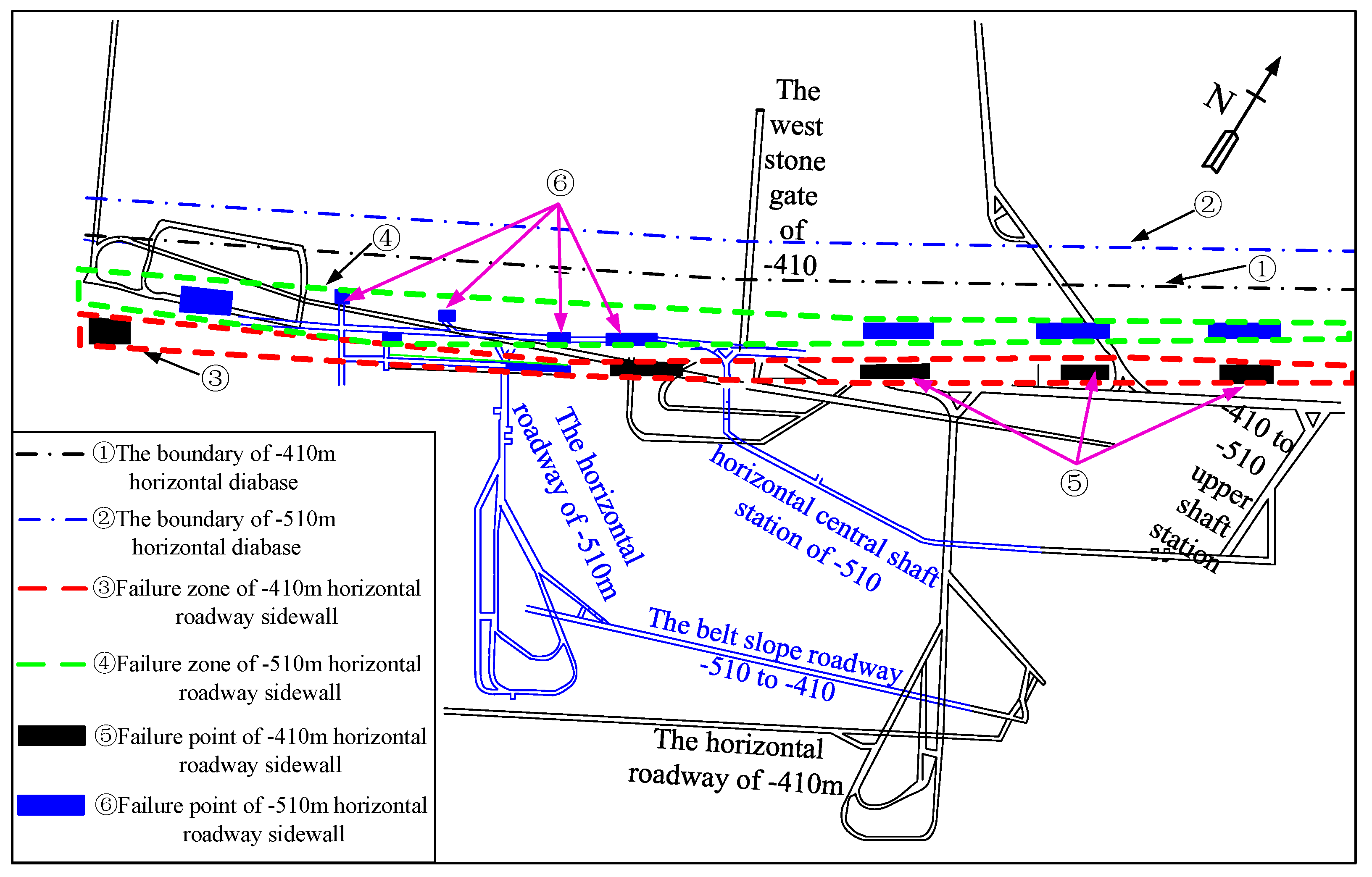
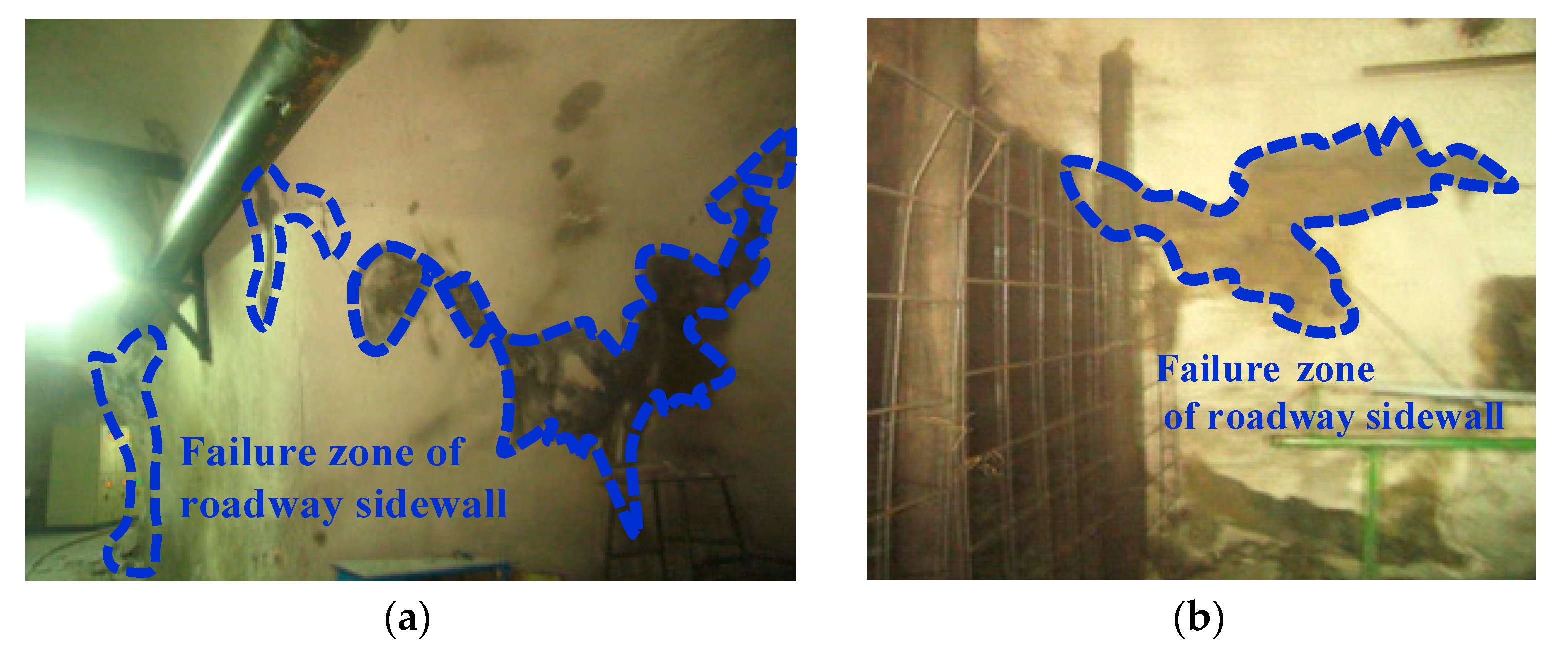
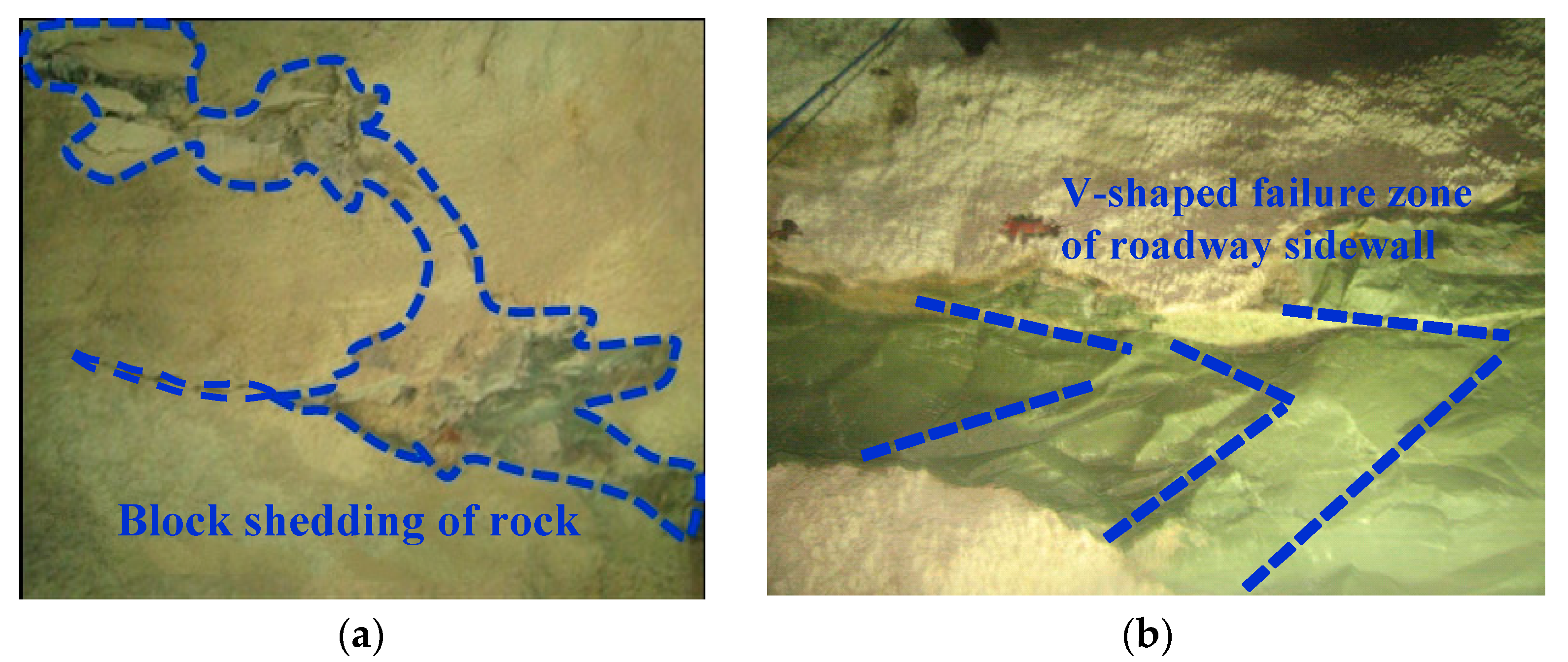
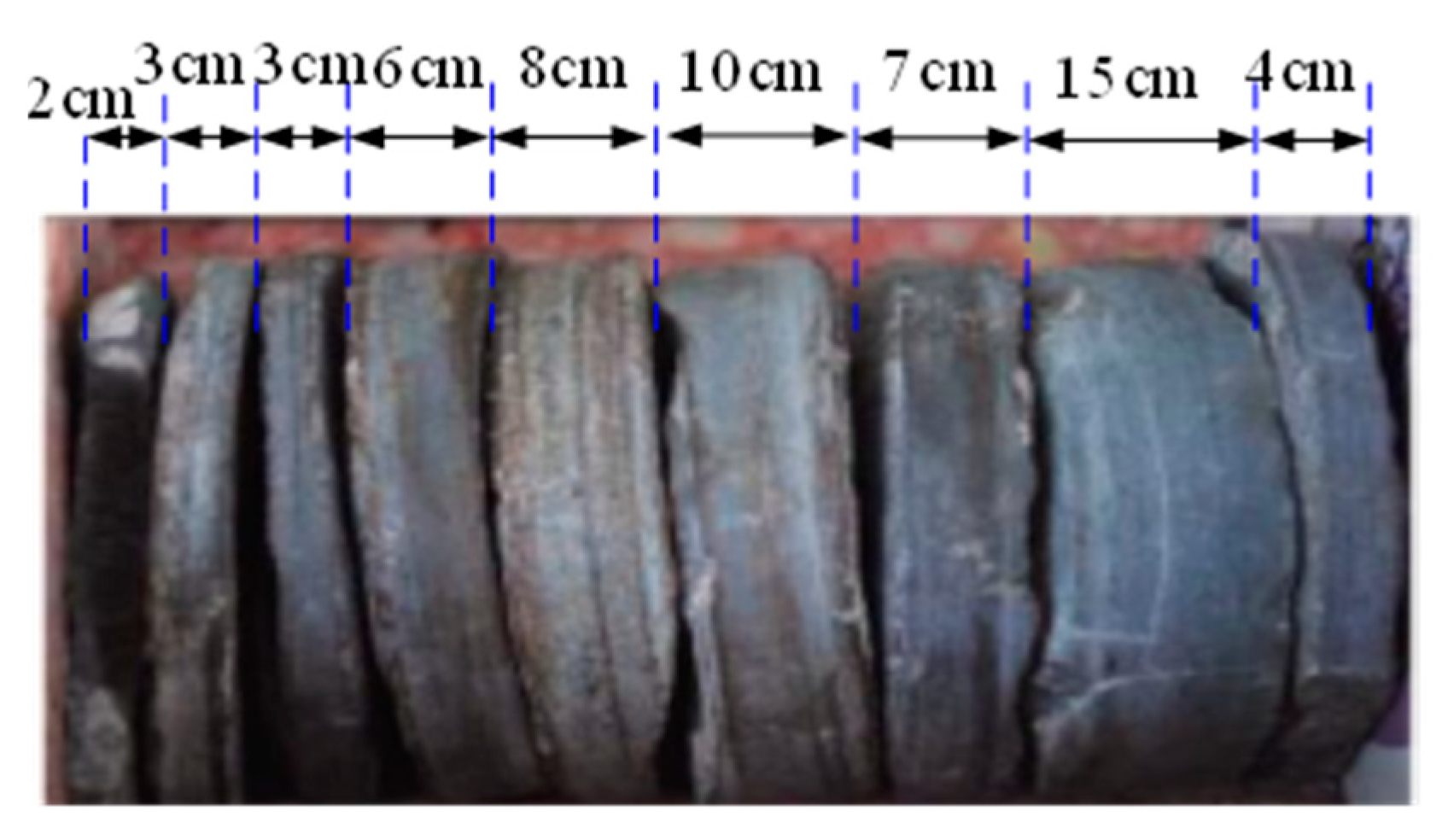
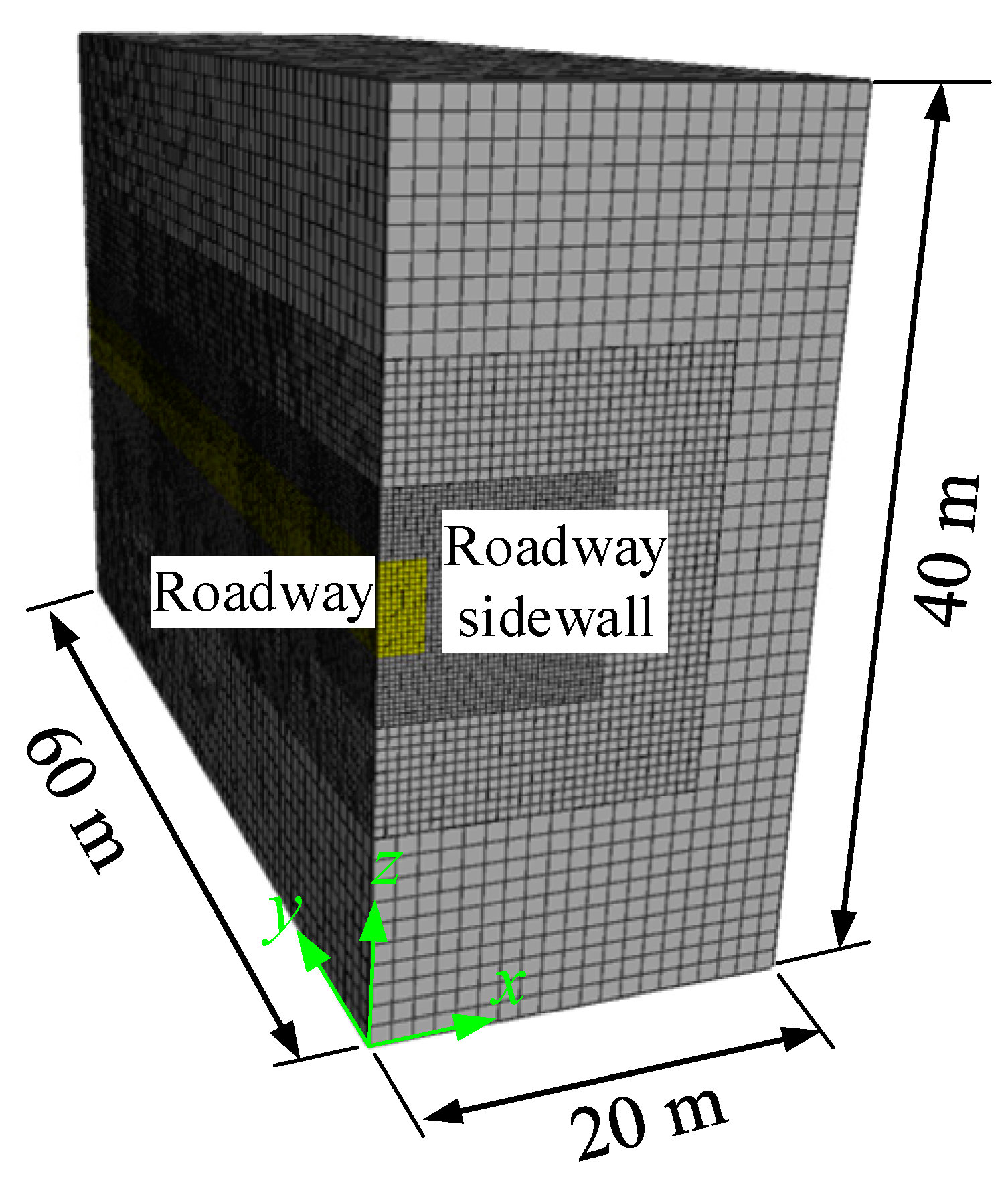
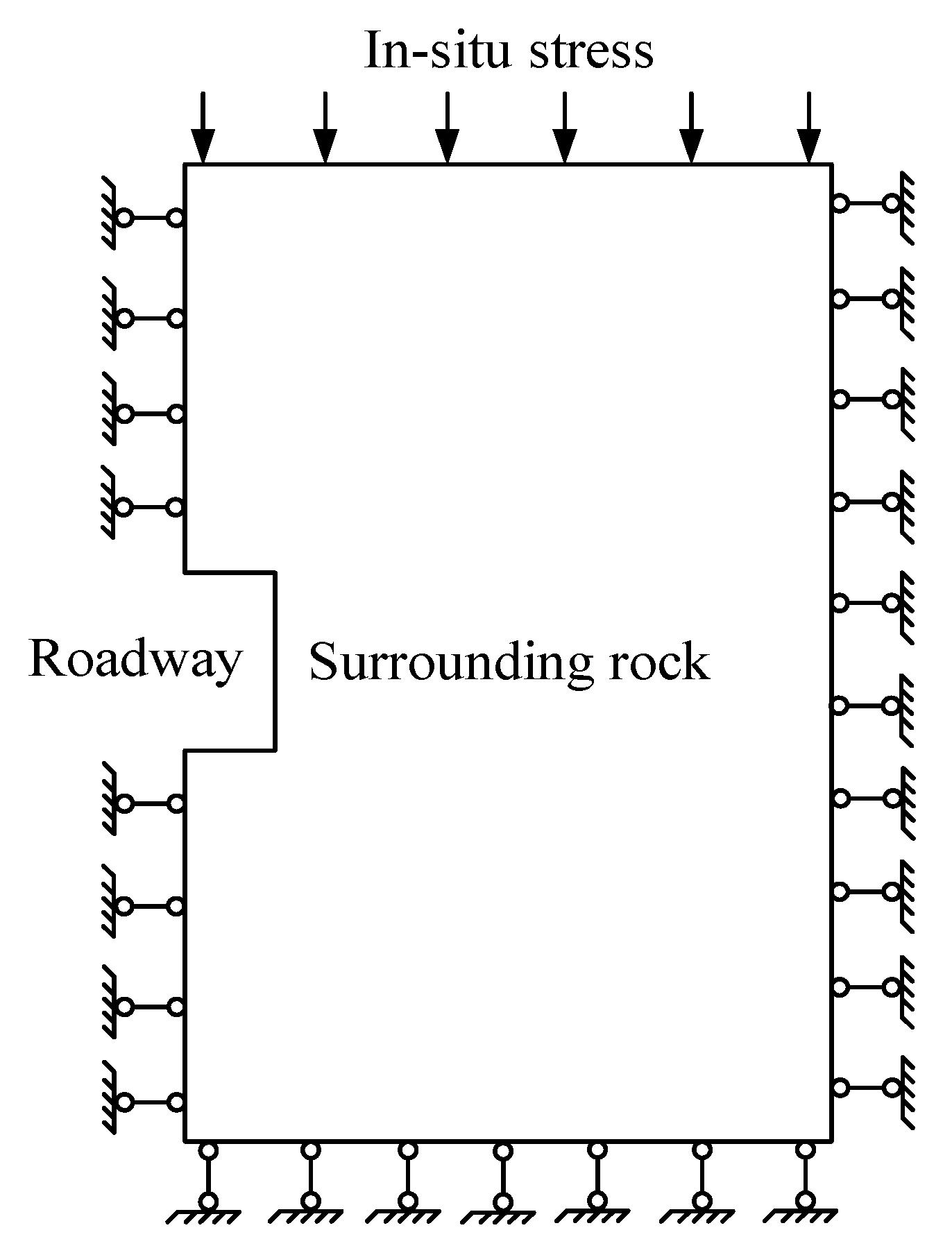
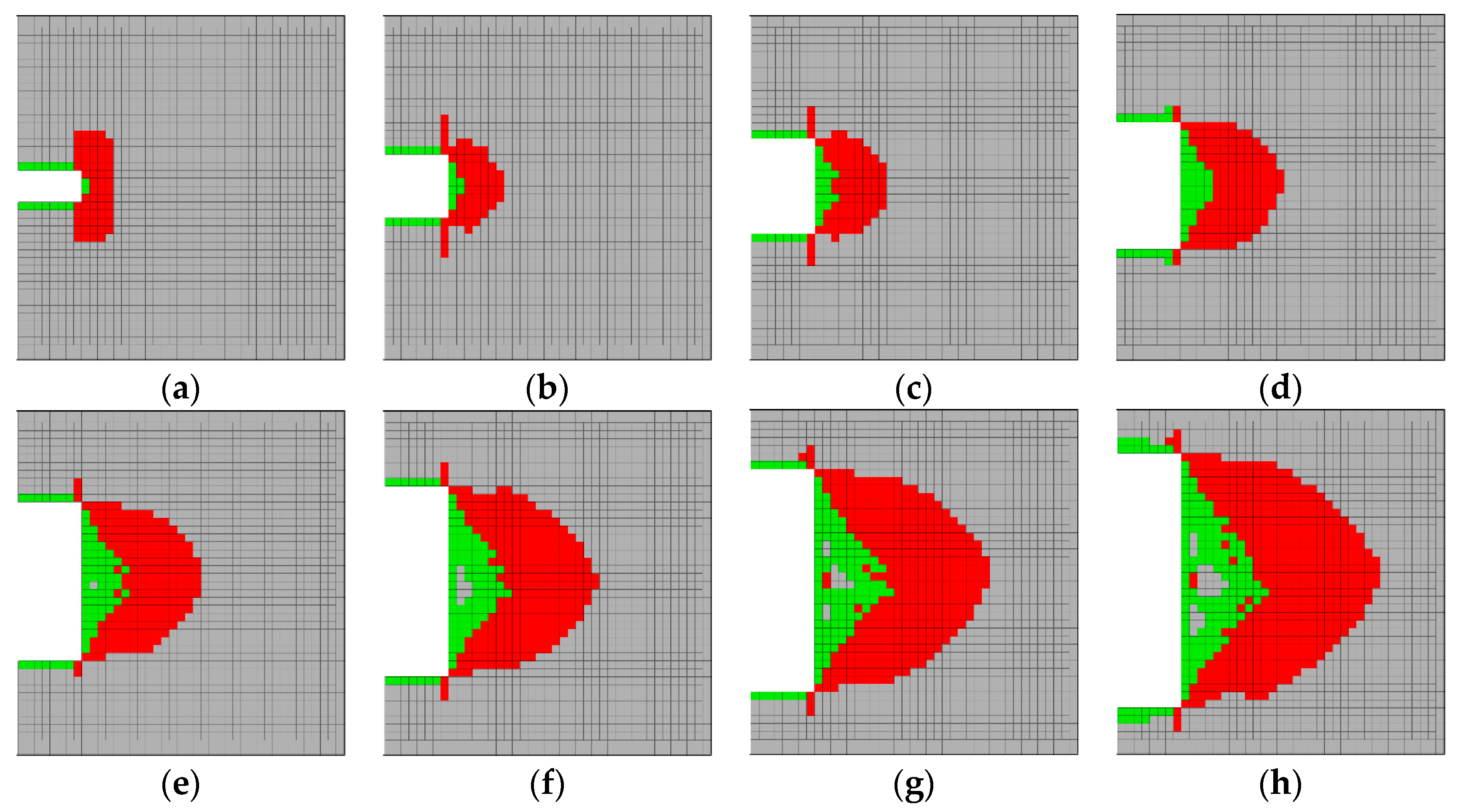

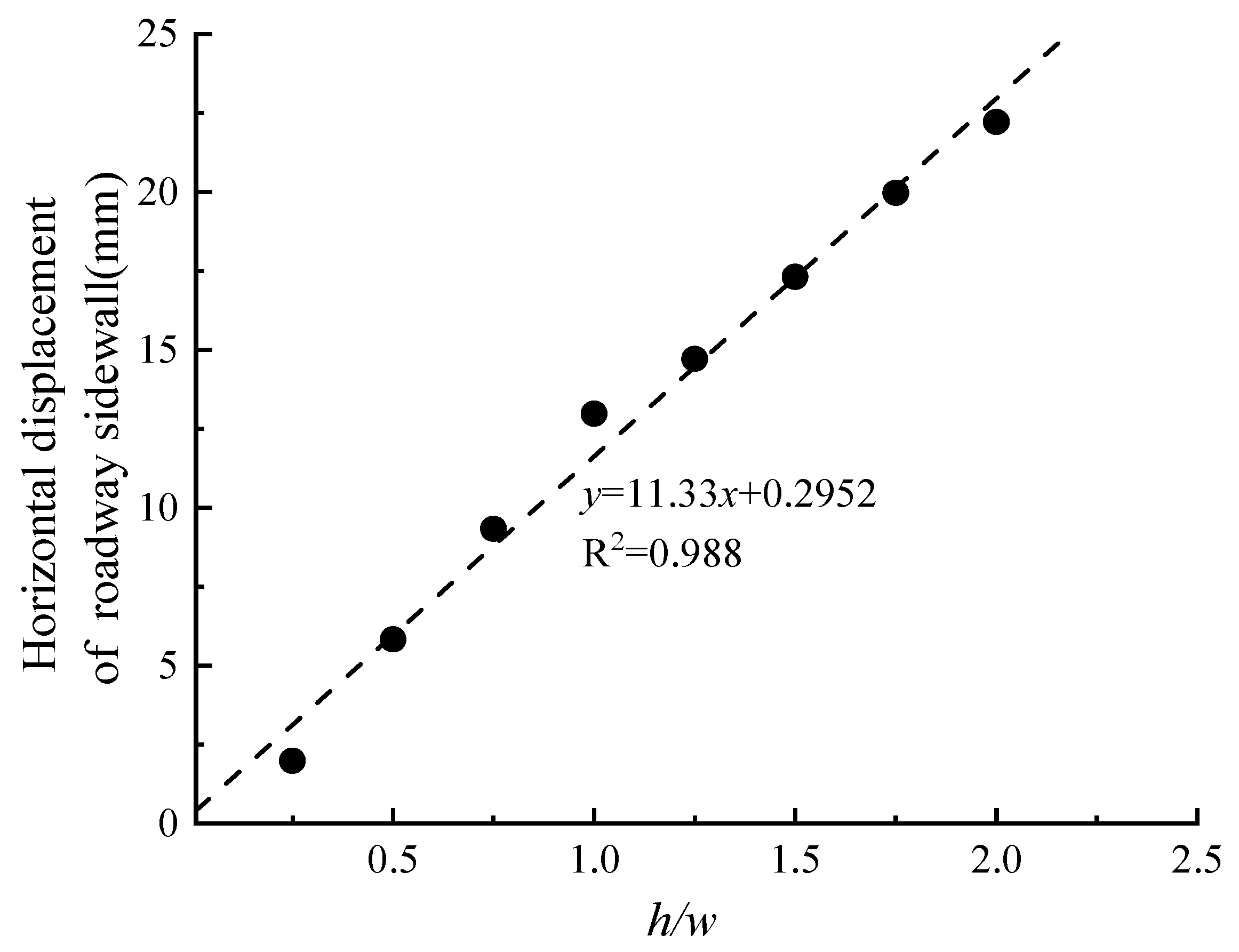
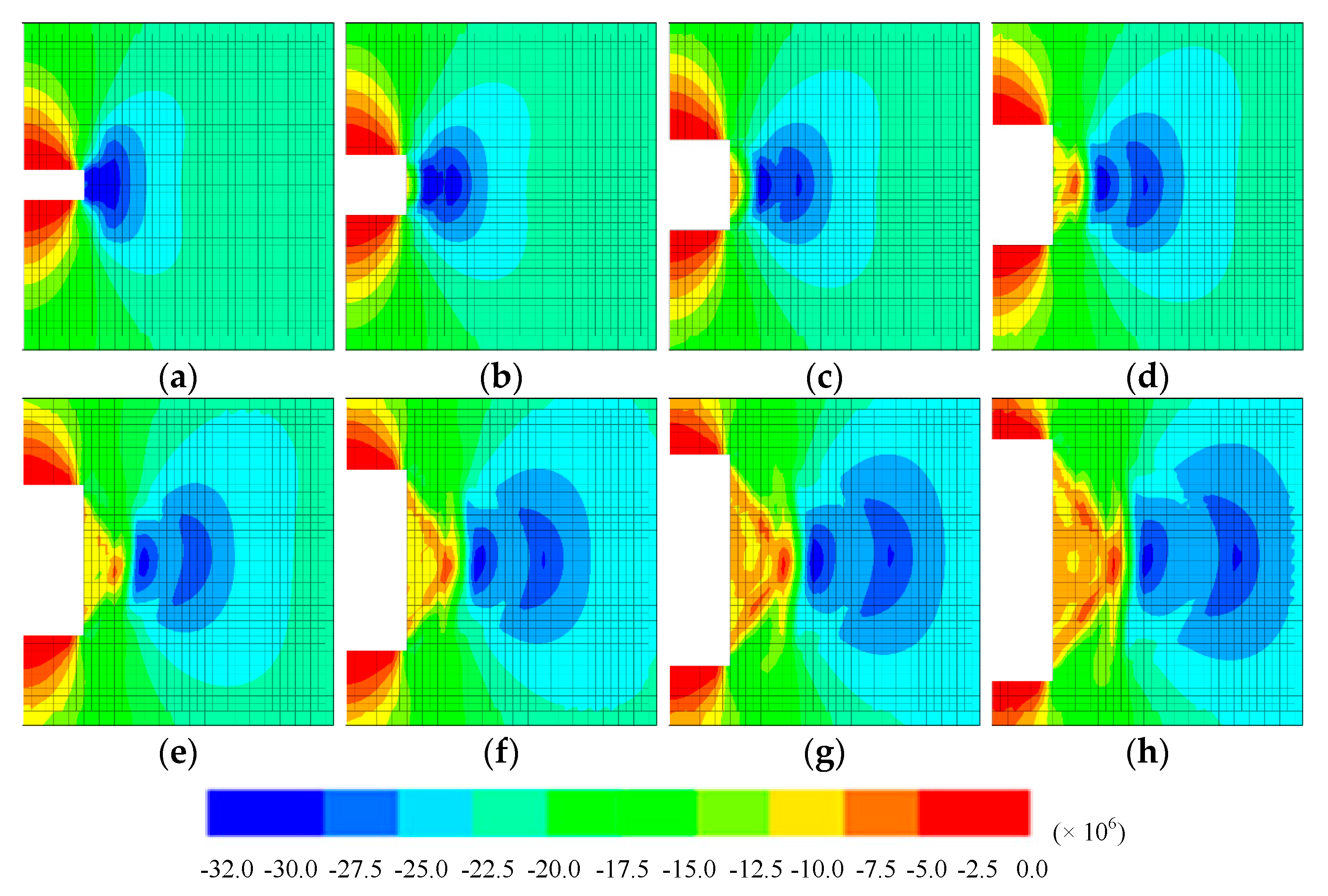
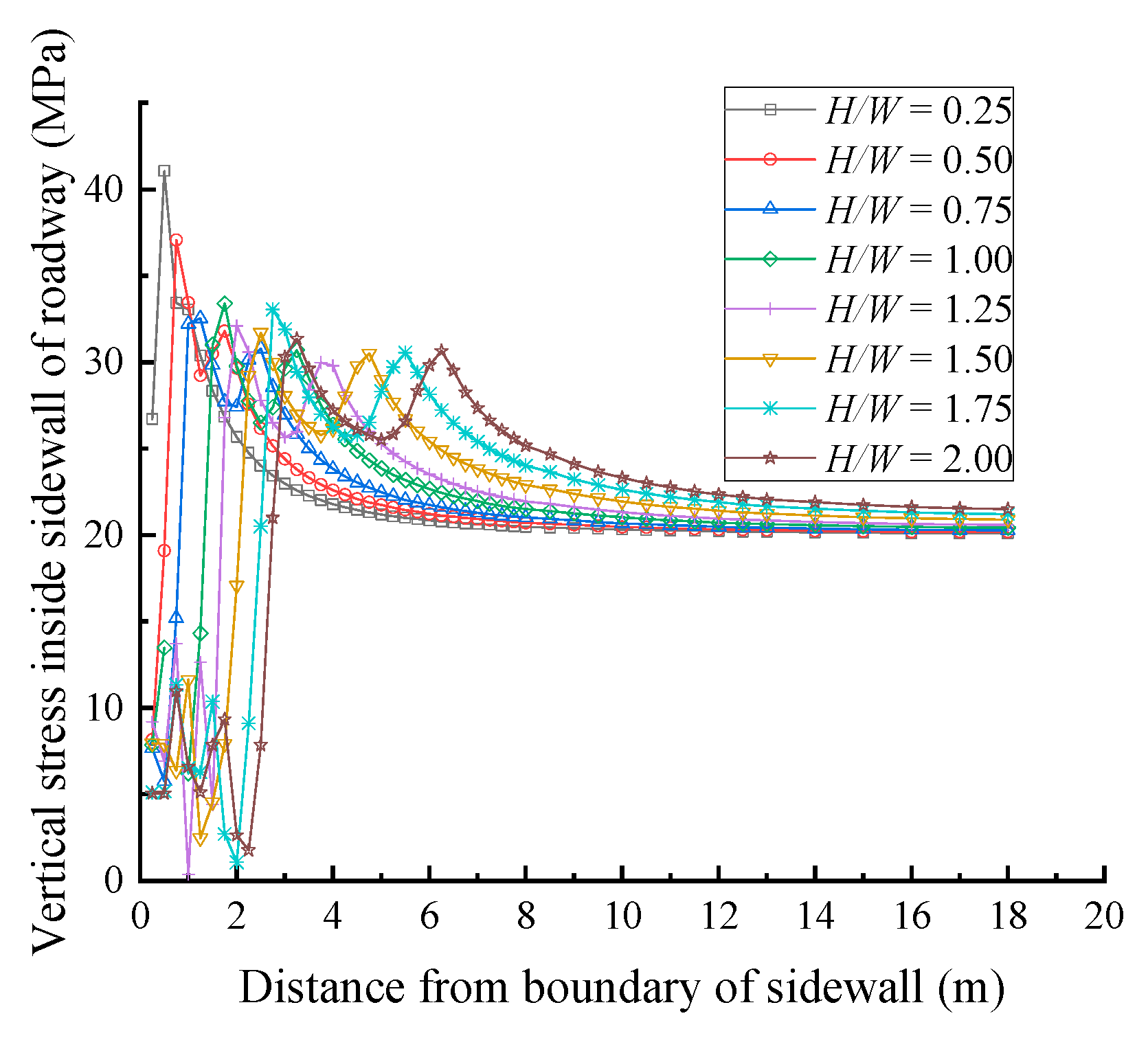
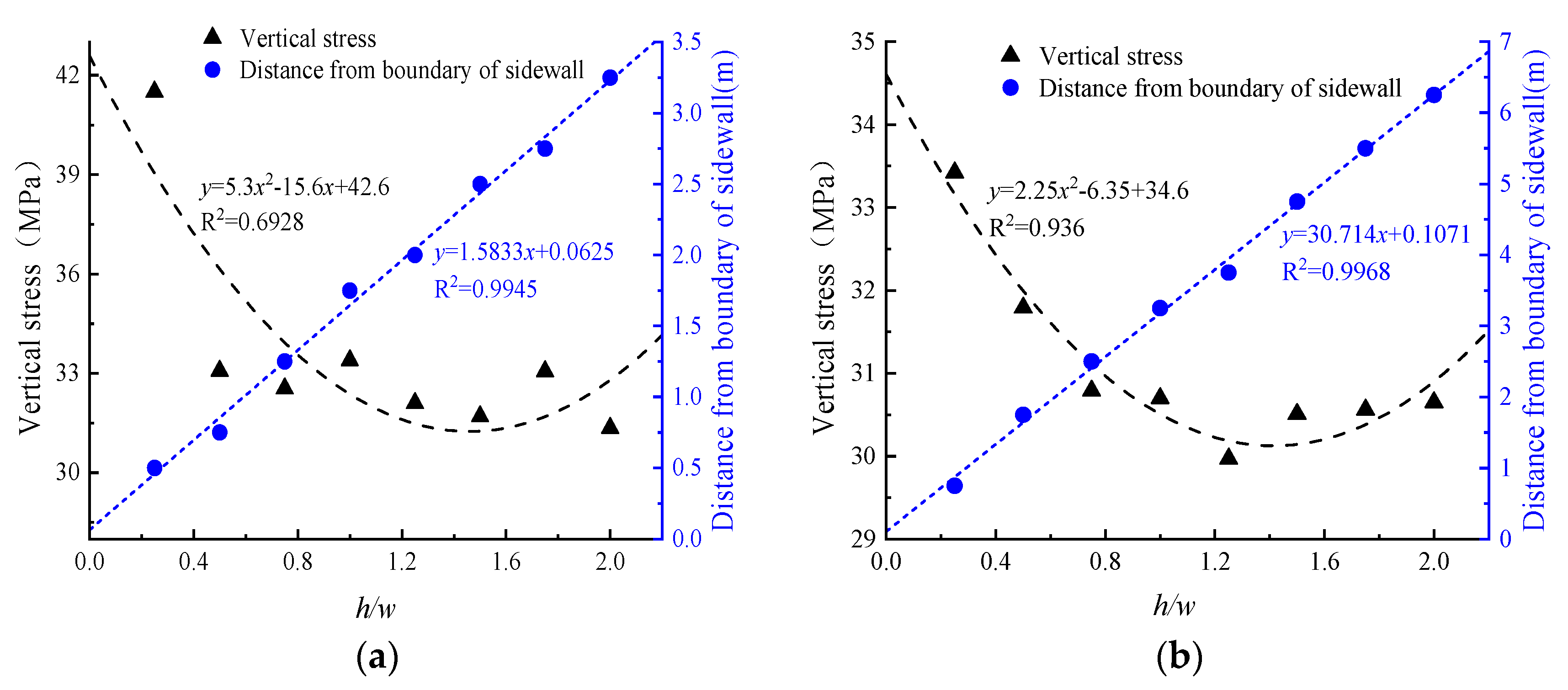
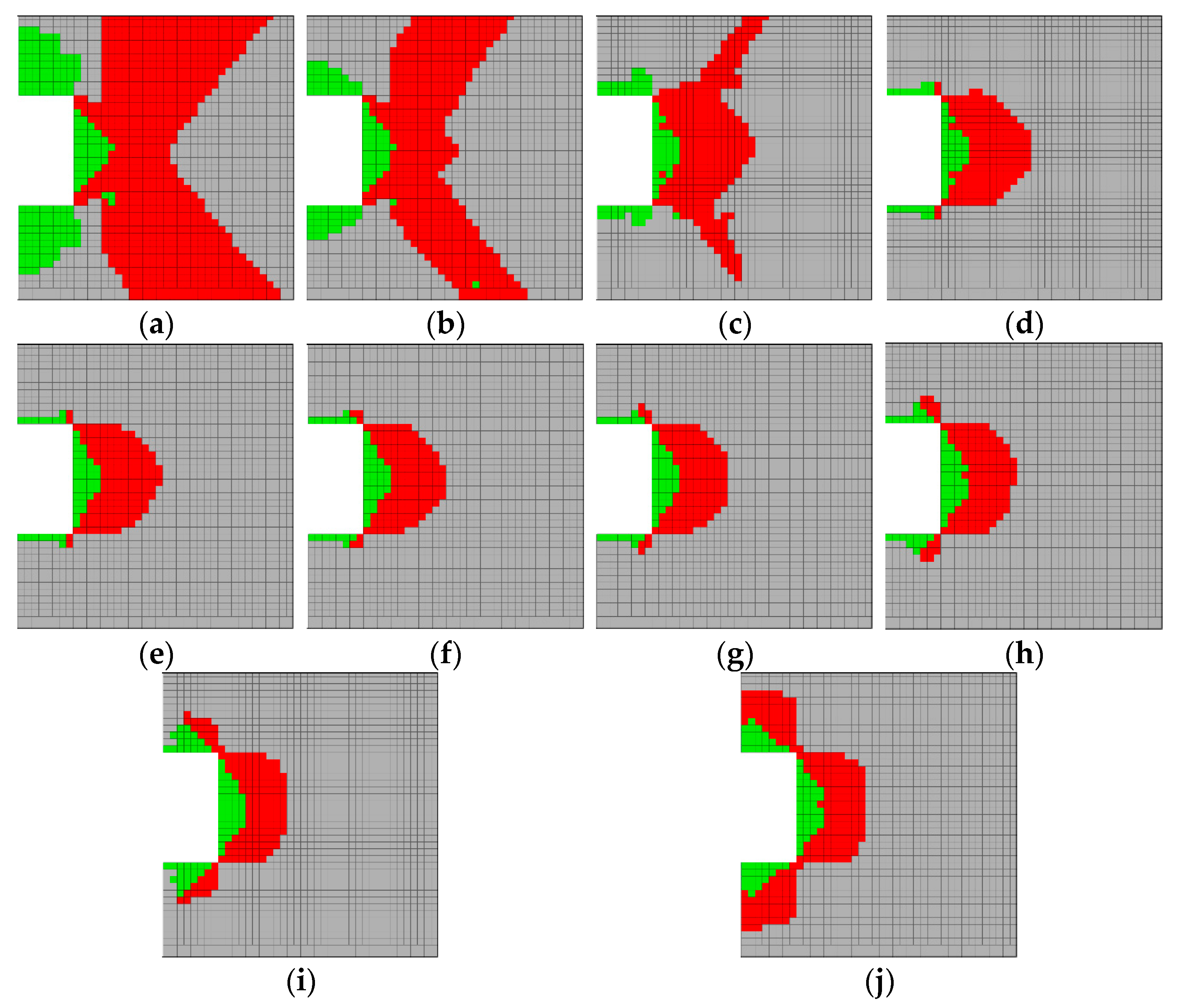
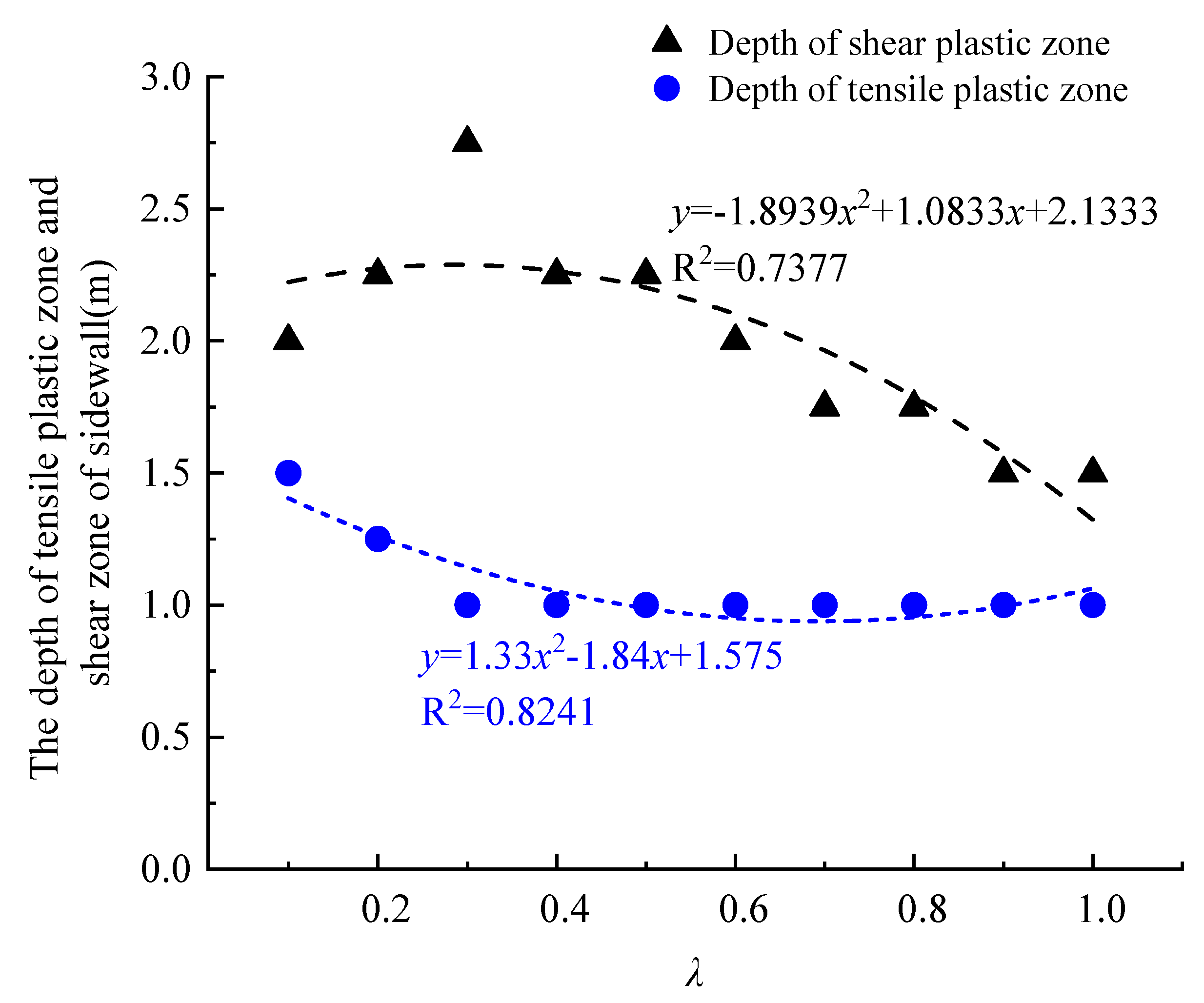

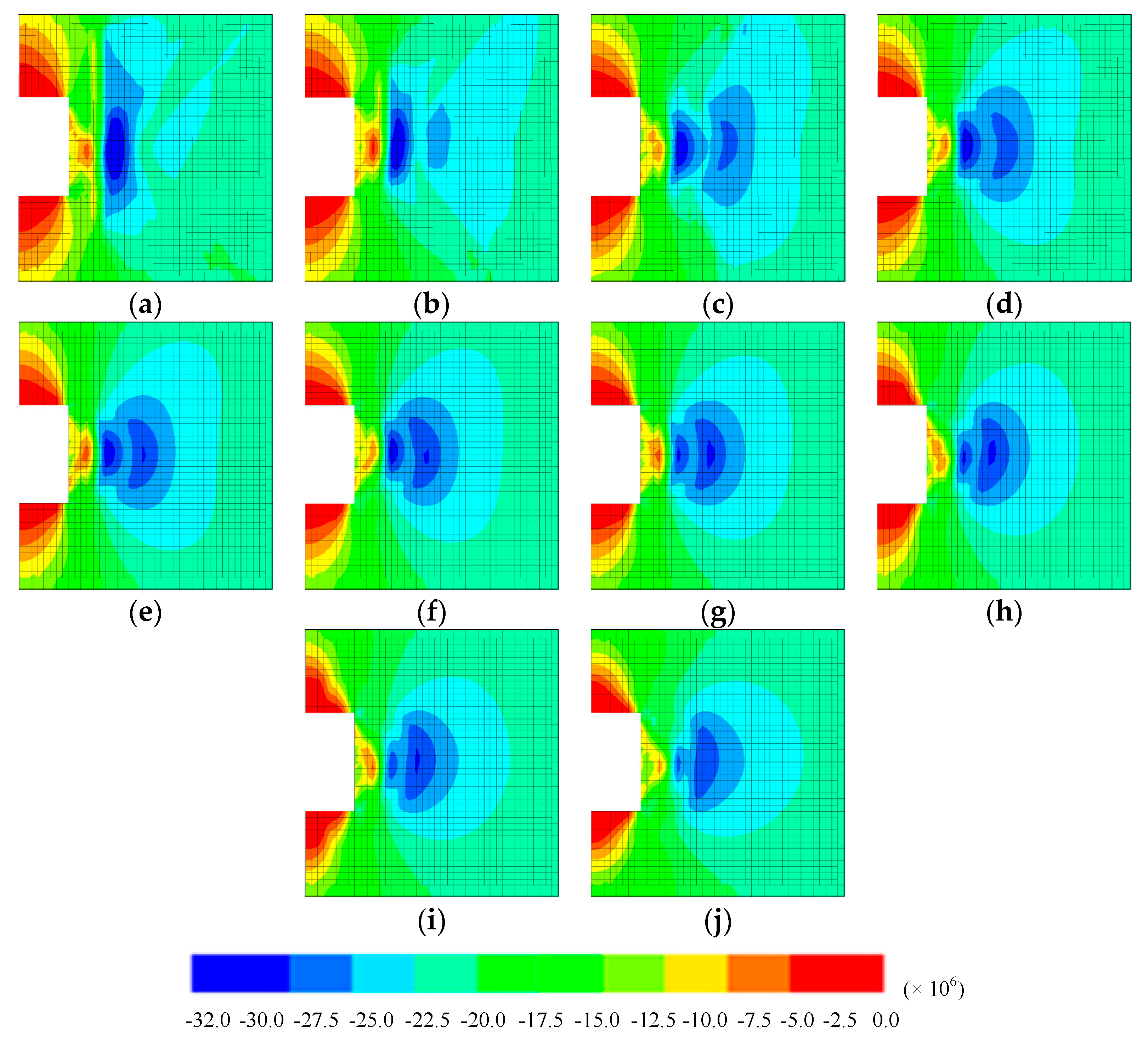
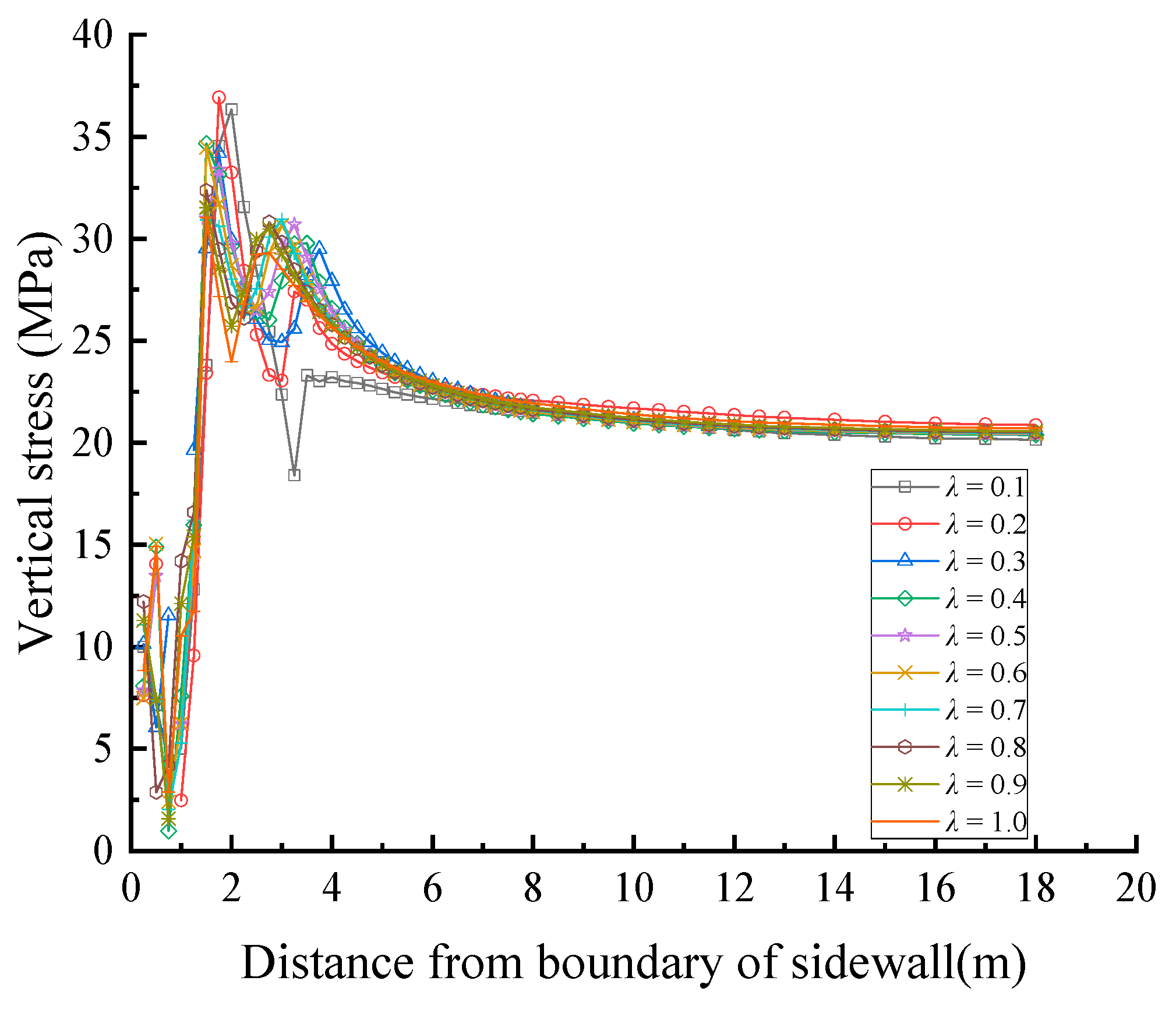
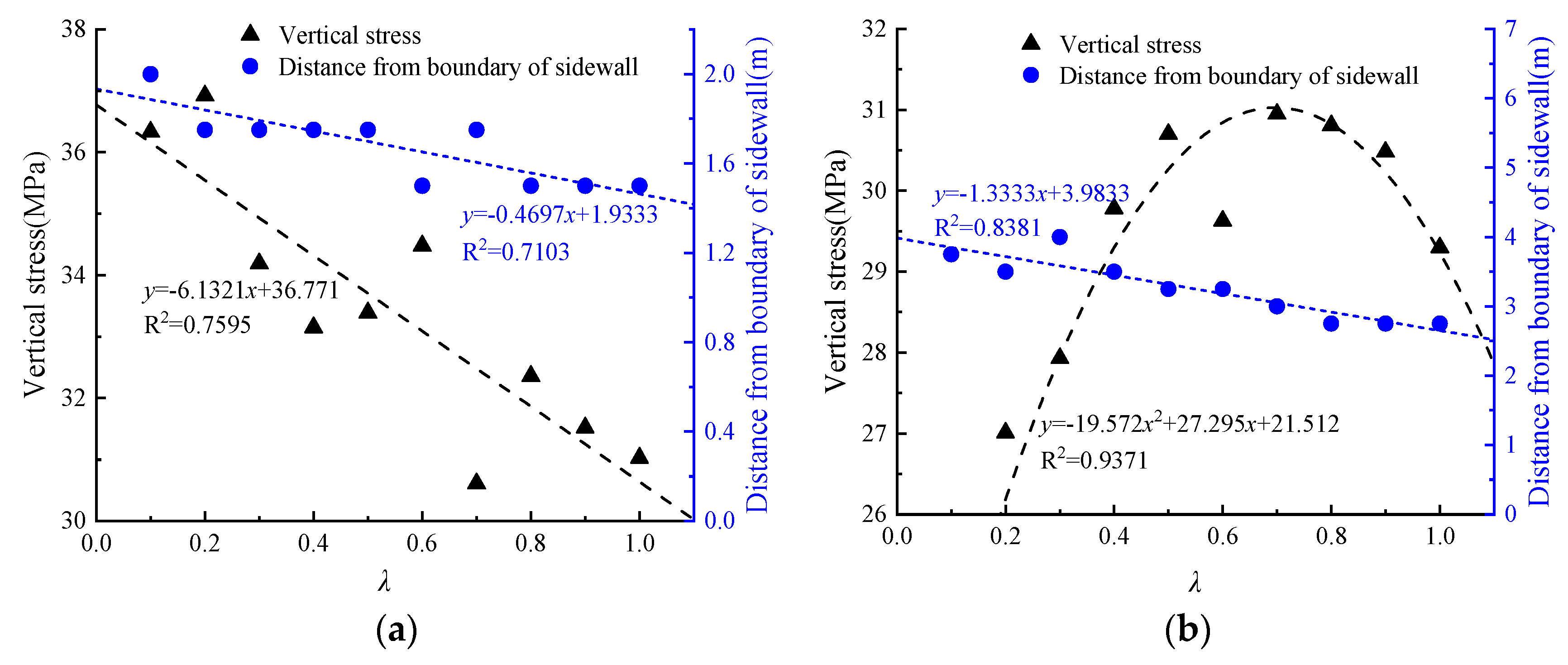
| Number of Measuring Points | Principal Stress | Principal Stress Value (MPa) | Principal Stress Direction (°) | |
|---|---|---|---|---|
| Azimuth Angle | Dip Angle | |||
| 1 | σ1 | 45.69 | 154.91 | −2.11 |
| σ2 | 24.44 | 80.21 | 77.62 | |
| σ3 | 19.10 | 244.85 | 8.95 | |
| 2 | σ1 | 49.30 | 156.79 | −2.40 |
| σ2 | 25.63 | 80.21 | 79.76 | |
| σ3 | 18.46 | 246.37 | 9.95 | |
| Name | E (GPa) | v | c (MPa) | φ (°) | ρ (g/cm3) |
|---|---|---|---|---|---|
| Diabase | 25 | 0.24 | 10 | 42 | 2.83 |
| Scheme | Roadway Height-Width Ratio h/w | Lateral Pressure Coefficient λ |
|---|---|---|
| Scheme 1 | 0.25, 0.50, 0.75, 1.0, 1.25, 1.50, 1.75, 2.00 | 0.5 |
| Scheme 2 | 1.0 | 0.1, 0.2, 0.3, 0.4, 0.5, 0.6, 0.7, 0.8, 0.9, 1.0 |
Disclaimer/Publisher’s Note: The statements, opinions and data contained in all publications are solely those of the individual author(s) and contributor(s) and not of MDPI and/or the editor(s). MDPI and/or the editor(s) disclaim responsibility for any injury to people or property resulting from any ideas, methods, instructions or products referred to in the content. |
© 2024 by the authors. Licensee MDPI, Basel, Switzerland. This article is an open access article distributed under the terms and conditions of the Creative Commons Attribution (CC BY) license (https://creativecommons.org/licenses/by/4.0/).
Share and Cite
Wu, X.; Zhang, Y.; Xing, M.; Jiang, B.; Fu, J. Numerical Study on Failure Mechanisms of Deep Roadway Sidewalls with Different Height-Width Ratios and Lateral Pressures. Appl. Sci. 2024, 14, 3892. https://doi.org/10.3390/app14093892
Wu X, Zhang Y, Xing M, Jiang B, Fu J. Numerical Study on Failure Mechanisms of Deep Roadway Sidewalls with Different Height-Width Ratios and Lateral Pressures. Applied Sciences. 2024; 14(9):3892. https://doi.org/10.3390/app14093892
Chicago/Turabian StyleWu, Xingzhong, Yubao Zhang, Minglu Xing, Bo Jiang, and Jianye Fu. 2024. "Numerical Study on Failure Mechanisms of Deep Roadway Sidewalls with Different Height-Width Ratios and Lateral Pressures" Applied Sciences 14, no. 9: 3892. https://doi.org/10.3390/app14093892
APA StyleWu, X., Zhang, Y., Xing, M., Jiang, B., & Fu, J. (2024). Numerical Study on Failure Mechanisms of Deep Roadway Sidewalls with Different Height-Width Ratios and Lateral Pressures. Applied Sciences, 14(9), 3892. https://doi.org/10.3390/app14093892






